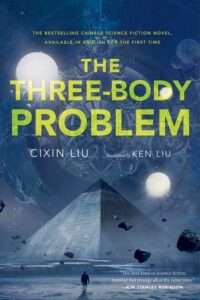
The Three-Body Problem is ambitious. It hearkens back to writers like Larry Niven with a grand idea and hard science approach. In The Three-Body Problem, which won the Hugo Award for best science fiction in 2015, the story begins during China’s Cultural Revolution in 1967. Ye Wenjie, a young astrophysicist, watches as her father is murdered in front of crowd for failing to recant the fundamentals of relativity. We see an embracing of ignorance and rejection of science and reason among the populace. Soon after this moment, Ye Wenjie is sent to the countryside to cut lumber and be re-educated. Even though she tries to stay safe from the communist party’s political wing, Ye Wenjie is given a copy of Silent Spring by a journalist for the communist party. The book moves Ye Wenjie. She sees the deforestation around her and it echoes Rachel Carson’s book. However, this moment leads to another betrayal and Ye Wenjie winds up at Red Coast Base.
Due to Ye Wenjie’s background she’s assigned / imprisoned to work at the base. The base is essentially a high-power radio transmitter with the purpose to overheat and fry components in Western satellites and spacecraft. At least, that is what Ye Wenjie is initially told.
As Ye Wenjie gains more trust over the years, her higher-ups tell her the true mission of Red Coast: to search for alien life. How can Red Coast make contact though? “Research,” says Wenjie, “shows that in order for extraterrestrials to detect our signals, we must broadcast to a power level equal to the output of a mid-sized star.”
The novel takes place in two competing timeframes. Ye Wenjie’s story is interspersed with sections in the present time. Scientists, mostly physicists, are committing suicide. There is a strange, online video game that lures curious and brilliant people to play. The goal is to solve the three-body problem and allow a simulated civilization to survive. Also, the laws of physics seem to no longer work as laws. What’s happening?
Contact with a civilization much greater than ours. What are their intentions? How will humanity respond? If a blockade is put on Earth’s scientific development, what will it mean for us? These are all questions that Cixin Liu explores.
At times, the writing felt clunky. I’m not sure if that’s due to the translator, as the second novel, translated by someone else, is more engaging, or if Liu’s writing and editing improved. What I loved about this book was the perspective. It was enjoyable reading Chinese science fiction and seeing how the political wing of the Communist Party might be so intertwined with science and exploration. At times, I struggled with names, but that’s just a small detail and doesn’t detract from the story.
It’s hard to write about this novel without giving too much away. If you enjoy classic science fiction and you’re open to reading translation, The Three-Body Problem will not disappoint. Moreover, it’s the first book in a series, and the second book is wonderful.



